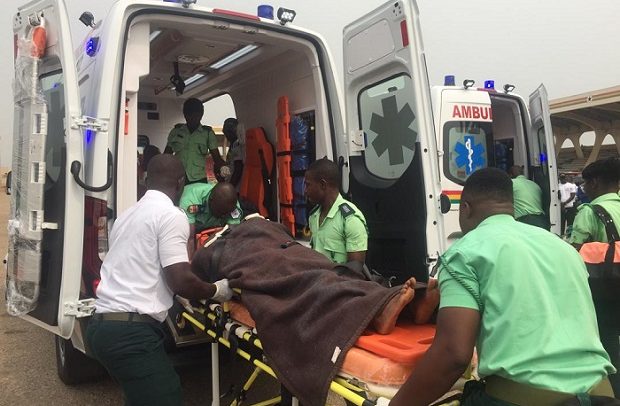Simulation exercise for the ambulances
The procurement and commissioning of the 307 ambulances has added a total of 145 new ambulance stations to the National Ambulance Service (NAS) Stations nationwide.
According to the Chief Executive Officer (CEO) of NAS, Prof. Ahmed Nuhu Zakariah, the 145 new stations are the highest single addition in the history of ambulance service in Ghana.
He stated that 307 is the highest fleet in the history of the procurement of ambulances for emergency healthcare in Africa.
Prof. Zakariah made this known in his welcome address at the commissioning of the ambulances on Tuesday, January 28, 2020, at the Black Star Square in Accra.

Tracing the birth and growth of NAS, he described the commissioning ceremony as a great day in the history of Ghana.
He said NAS was conceived in 2004 and started in 2005 with seven stations in three regions.
In 2006, he noted, it started full scale operation with additional 12 stations.
Distribution
Out of the 307 ambulances, 275 will go to the constituencies, with the remaining ones going to other hospitals, emergency areas nationwide and possibly the National Disaster Management Organization (NADMO).
The ambulances form part of one of the largest consignment so far in the history of Ghana.
The ambulances were procured under the government Infrastructure for Poverty Eradication Programme (IPEP) currently being implemented by the Ministry of Special Development Initiatives.

Since the establishment of the Ghana Ambulance Service with an initial investment by the Kufuor Administration in 2004 with some 10 ambulances and 7 stations, emergency health care has in recent years ground to a halt leaving the ambulance service with some 55 ambulances functioning currently only and a handful of Emergency Medical Technicians.
Some Beneficiary Constituencies
Some of the beneficiary constituencies are: Abura Asebu Kwamankese, Bodi, Sefwi-Wiaso, Ablekuma South, Odododiodio, Ahanta West, Twifo-Ati Morkwa, South Dayi, Ho West Abuakwa South, Ofoase-Ayirebi, Manhyia North, Ahafo Ano South West, Asunafo North, Techiman South, Berekum West, Jirapa, Salaga South, Mion, Yagabaikubori, Bolgatanga Central, Binduri, Nalerigu/Gambaga, Wulensi, Salaga North, Wa Central, Dormaa Central, Sene East, Effiduase Asokore, Bekwai, Manso Nkwanta, Afram Plains North, Mpraeso, Hohoe, North Dayi, Effutu, Wassa East, Ningo-Prampram, Prestea/Huni-Valley, Amenfi East, Juaboso, Sefwi Akontombra, Takoradi, Tarkwa-Nsuaem, Kwadaso, Nhyiaeso, Ashaiman, Amenfi West, Chiana/Paga, Zebilla, Bolgatanga East, Tempane, Pusiga, Navrongo Central, Chereponi, Talensi, Mampong, Manso Adubia, Obuasi East, Asutifi North, Old Tafo, and Ledzokuku, Krowor, Tema West, Madina, Tema East, Ayawaso North, Dome-Kwabenya, Ayawaso East, Sege, Bortianor-Ngleshie-Amanfrom, Ayawaso Central, Cape Coast North,
Others are Abura Asebu Kwamankese, Bodi, Sefwi-Wiaso, Ablekuma South, Odododiodio, Ahanta West, Twifo-Ati Morkwa, South Dayi, Ho West Abuakwa South, Ofoase-Ayirebi, Manhyia North, Ahafo Ano South West, Asunafo North, Techiman South, Berekum West, Jirapa, Salaga South, Mion, Yagabaikubori, Bolgatanga Central, Binduri, Nalerigu/Gambaga, Wulensi, Salaga North, Wa Central, Dormaa Central, Sene East, Effiduase Asokore, Bekwai, Manso Nkwanta, Afram Plains North, Mpraeso, Hohoe, North Dayi, Effutu, Wassa East, Ningo-Prampram, Prestea/Huni-Valley, Amenfi East, Juaboso, Sefwi Akontombra, Takoradi, Tarkwa-Nsuaem, Kwadaso, Nhyiaeso, Ashaiman, Amenfi West, Chiana/Paga, Zebilla, Bolgatanga East, Tempane, Pusiga, Navrongo Central, Chereponi, Talensi, Bia East, Bibiani Anhwiaso Bekwai, Suaman, Esikadu/Ketan, Ellembelle, Amenfi Central, Domeabra-Obom, Upper Denkyira West, Gomoa East, Agona East, Okaikwei Central, Nkwanta North, Tano North, Nkwanta South, Awutu Senya East, Upper Denkyira East, Lower West Akim, Awutu Senya West, Buem, Asante Akim North, Fomena.
By Melvin Tarlue


